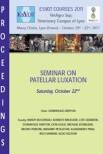Objective: To compare the accuracy of three-dimensional (3D) printed patient-specific guide (PSG) with a freehand (FH) approach for radial osteotomies in ex vivo normal dogs.
Study design: Experimental study.
Animals: Twenty four ex vivo thoracic limb pairs from normal beagle dogs.
Methods: Computed tomography (CT) images were collected preoperatively and postoperatively. Three osteotomies tested (n = 8/group) were: (1) uniplanar 30° frontal plane wedge ostectomy, (2) oblique plane (30° frontal, 15° sagittal) wedge ostectomy, and (3) single oblique plane osteotomy (SOO, 30° frontal, 15° sagittal, and 30° external). Limb pairs were randomized to a 3D PSG or FH approach. The resultant osteotomies were compared with virtual target osteotomies by surface shape-matching postoperative to the preoperative radii.
Results: The mean ± standard deviation osteotomy angle deviation for all 3D PSG osteotomies (2.8 ± 2.8°, range 0.11-14.1°) was less than for the FH osteotomies (6.4 ± 6.0°, range 0.03-29.7°). No differences were found for osteotomy location in any group. In total, 84% of 3D PSG osteotomies were within 5° deviance from the target compared to 50% of freehand osteotomies.
Conclusion: Three-dimensional PSG improved FH accuracy of osteotomy angle in select planes and the most complex osteotomy orientation in a normal ex vivo radial model.
Clinical significance: Three-dimensional PSGs provided more consistent accuracy, which was most notable in complex radial osteotomies. Future work is needed to investigate guided osteotomies in dogs with antebrachial bone deformities.









